GETTING THINGS DONE (hereafter GTD) has had a big impact on me. As witness, this post shows as much of the before/after GTD as I can articulate, it will evolve as I refine the post into enough detail to please visual learners (you know who you are John Nieberall!).
Question 1: What is GTD?
To my mind, GTD is an architecture for information organization and processing that allows a person to maximize efficiency and effectiveness while dealing with overwhelming inflows of drama and data under deadline. GTD may look like a self help book, it may feel like a religious cult when you have a GTD evangelist on your chest (hi Ian!) telling you to read and then buy crap, and then re-read. But, GTD is information organization architecture.
GTD is important because life does not come with an owner’s manual that says “get organized in a sustainable high performance way.” So people go through school, work, phd programs (I did all three) and never spend a day getting organized beyond coping with the next deadline.
Here is the GTD architecture diagram taken from the PDF accompanying the Audible version of GTD:
Question 2: What did your life/office look like before GTD (circa 2009)?
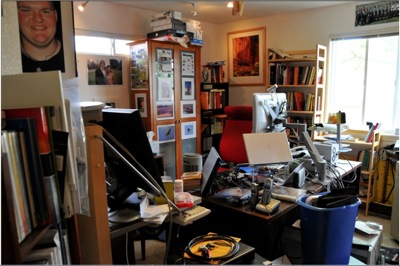

Not in the office, I also had a 5 drawer horizontal filing cabinet with 94,000 pages of journal articles, research data, and miscellaneous documents that were too good to throw out but not good enough to use. Here is the filing cabinet in the garage next to the Y2K water barrel.
Question 3: What does your life/desk (Circa 2012) look like after implementing GTD?
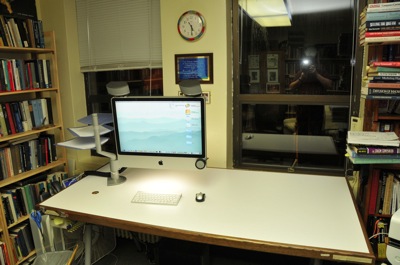
Note that this desk is: (1) large 6′ x 35″, (2) clutter free from the surface up 6″, (3) canted (the front edge is 1″ closer to the floor than the back edge. I will write more posts on desks and their requirements as taking back my desk was a key stepping stone for implementing GTD.
Next comes my physical filing system (Target totes) with 5″ book ends in the tote if there are not enough manilla folders to completely fill the tote:
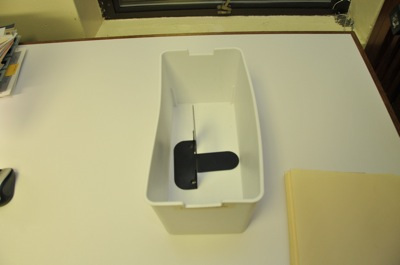
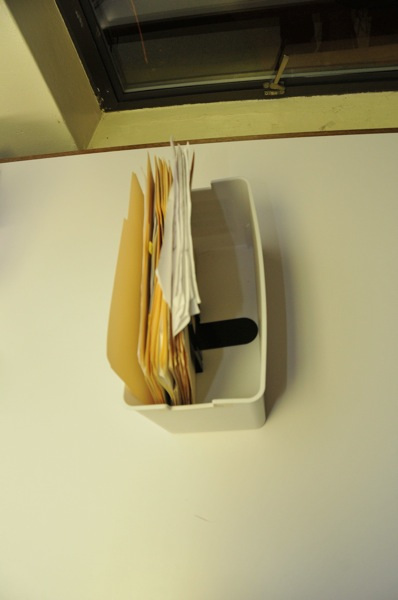
Before GTD had the 5 drawer horizontal file cabinet, after GTD has an electronic reference filing system in Evernote:
To get from paper to Evernote I raked through the 94,000 pages of paper in the file cabinet, and ask myself for each document “Will there ever be a next action for this document?” 80% of the documents were instant “No!” and they went straight into recycling. The 20% that were yes or maybe, were 17,500 pages which I scanned in a week on my Fujitsu ScanSnap S1500.
Here is my annual capture of reference file information. The median monthly count of documents captured, is 65. I enter more documents at the end of the year, which surprises me. Over time Evernote is becoming more and more essential as external short term memory. Many of the documents I capture in evernote are web pages, the evernote Webclipper and Evernote Clearly browser add ins have become indispensable for me.
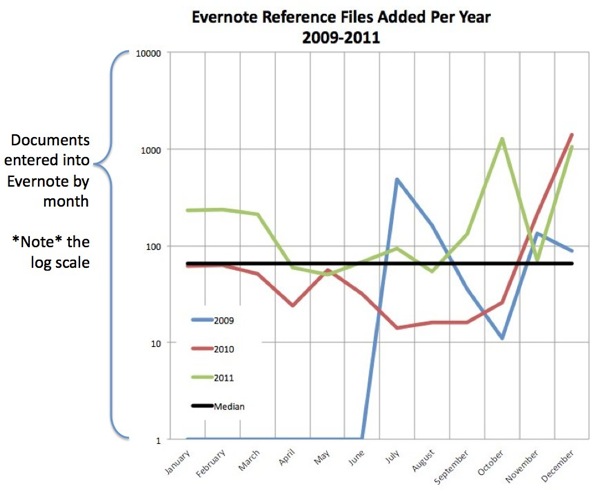
Here is my cumulative Evernote document count over the past three years. The exponential increase in files in evernote has happened as I have scanned and recycled. At the end of 2010 I scanned paper and recycled. At the end of 2011 I scanned a collection of 300 3.5″ floppy disks with research data sets and other archives on them.
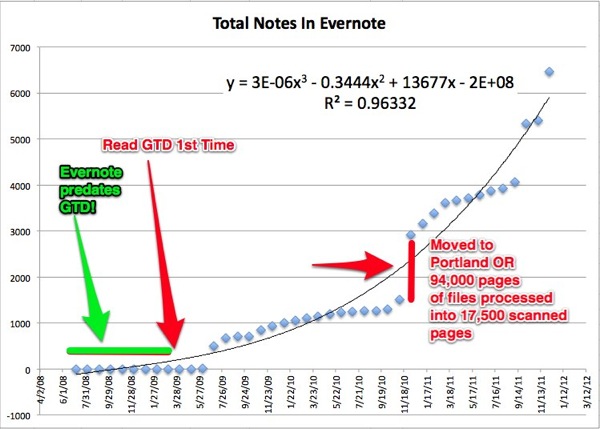
My final offering to the visual learner on Before/After GTD is a worksheet that covers more pieces of my system (GTDInfrastructureEvolution01b.xlsx):
Here is a summary view of how I am doing GTD after 3 years:
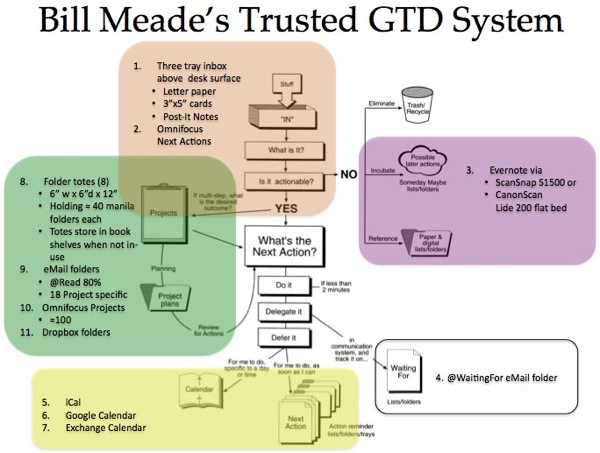

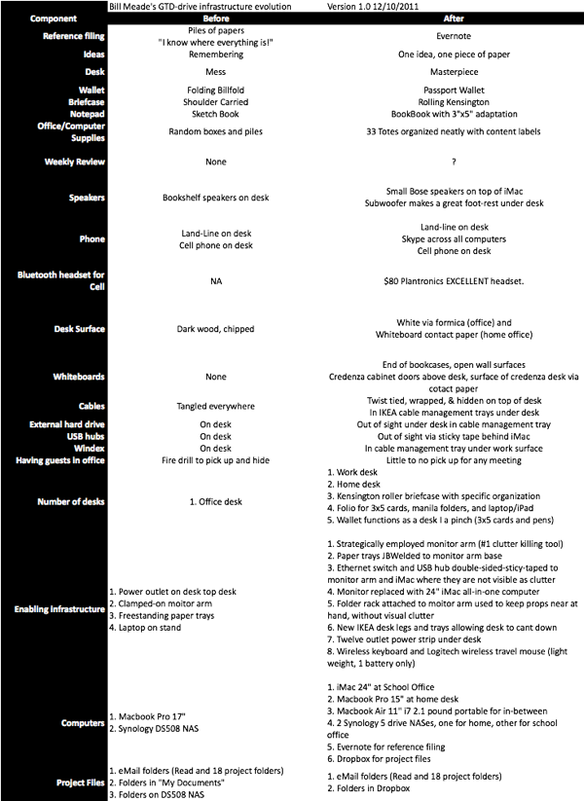
Pingback: Meade’s Theory of the Perfect GTD Desk | restartgtd
Pingback: Meade’s Theory of the Perfect GETTING THINGS DONE (GTD) Desk | restartgtd
Glad to visit this blog, keep it going.
“amazin”
Thank you! What do you wish you could talke to someone else about in GTD? [email protected]
AWESOME… really helpful as I’m trying to incorporate the same tools. Keep up the great work…
Could you go into a bit more detail on how you tag things in Evernote to make sure they’re easy to find/reference?
I find stuff in evernote by combining notebooks, search, and tags. I have 7,242 documents in my Evernote account. I have 95 folders, zero saved searches, and 320 tags. When I enter a document into evernote if the substance of the document is archival (scanner data from my PhD research for example) I’ll make a folder for that data and then just manually pile up the files into the notebook. If the substance of the document is general reference, I’ll most likely put the file into “Articles” which is a notebook that I have in mock-APLA sort order “author (year) Title” so that I can find the authors I read a lot (Kurzweil, Guy Kawasaki, or Steve Blank, or Geoff Moore) easily and quickly find the document I’m thinking of. When I import reference material I’m likely to make up a tag on the spot for it by asking myself “What is the one word that I will think to search on for this article?” But more and more, I just search for documents and find that any document in Evernote can be located by search. The tagging makes me feel safe, but I’m not sure that it is paying its way for me.
One thing I wish Evernote had, was in-attachment search. I just realized that Evernote is not searching within MS Word files (although it is searching fine in PowerPoint files) or my archived mbox Eudora mail archives. So, if you need to put a lot of weight on search, then Microsoft Search is likely a more robust solution. If you run Windows and have the Evernote client installed, you can use Microsoft search instead of Evernote’s search to get inside your attachments.
[email protected]
Wow, just found this blog. It looks great! Very useful and inspiring, it seems.
I’m also on my way back on the wagon, having gotten a boost by discovering the lethal combination of Evernote and ScanSnap S1500.
I’m also sad that Evernote only scans PDF and images.
How are you able to search the Evernote attachments with Windows Search?
As far as I understand it, the databases\attachments folder is only a buffer area / workspace that holds the attachments that you have been opening/manipulating on that computer.
I have about 1500 attachments in my database but only around 70 files in the attachments subfolder… ?
Assumption: You have the Evernote client for Windows installed on your computer. Then, when you put a file in Evernote, it stores that file locally on your Windows computer, and then replicates a file up to the cloud. It is my understanding that Windows search does the full text indexing of files on your local computer. Concordia University is a Windows shop. I’ve been in extended discussions with the Windows zealots about the pros and cons of Dropbox, Windows Search, and Evernote. The WinZealots maintain that Windows search is superior, because it indexes everything (with the exception of PDFs that have not had OCR run inside them).
What they really mean, is that Windows search gets inside Word files, Zip file, etc. Evernote goeth not there. :-)
But, if you want your PDFs searchable on Windows Search, you’d better run them through the Acrobat text recognition routines. And then, Windows search will find everything that is in Evernote, and everything that is in the attachments that Evernote does not index.
Like the 8-ball, if this does not satisfy, ask again!
[email protected]